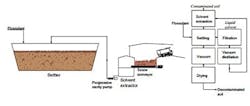Puzzler: Sort Out A Scale-Up Snafu
This Month’s Puzzler
I’m a new process engineer hired to sort out a botched expansion. The plant tried to increase production by replacing our reliable pressurized batch reactor with a vessel with double the capacity. The new system (see figure) has operated for three months but isn’t performing well.
In the new setup, we boosted the agitation by a factor of 30% but kept the same heat exchanger because, according to corporate, it was oversized by a factor of two — now, the capacity matches the theoretical heat load. In addition, we increased the pump motor size and added a variable frequency drive — before the scale-up, the pump ran at the bottom of its curve. We retained the steam control valve; the cooling water is on an open-closed valve. We got rid of the bottom shell baffle and also the pre-batch tank, which our researchers believe we don’t need. We largely duplicated everything else. The previous plant owners left scant records, so we had to go by modeling. The designers didn’t bother talking to any of the operators; it was a hostile takeover so the old managers and engineers aren’t cooperating.
I inspected the old vessel in the boneyard and noticed the bottom baffle was added later; the code stamp agrees. The agitation nozzle appears to have been beefed up, perhaps afterwards as well. I checked the motor and it’s always been in the same bucket.
Currently, we’re having difficulty starting the reactor. We also are having trouble cooling it down between batches. The relief valve on the vessel has popped twice in the past month — an operator told me that never happened before. The valve sticks open when it relieves. The viscosity is lower than expected, about 180 cP, suggesting a reversal of the reaction or incomplete reaction, and the temperature spikes above 180°F at the reactor outlet. I had the operators reduce the batch size by 30% and we seem to be making good product with the process in control.
Further complicating my troubleshooting, the new management changed the batch ingredients. The surviving laboratory technician from the old days says the viscosities and densities are higher.
What was done wrong? How can we get this process producing at the desired rate?
Tune The Process First
The problem description suggests scale-up issues. As far as I can determine, the batch processing capacity has gone up by 70% while reactor volume has doubled. Because some components remained the same, you need to check if they are the bottleneck. (Given the change in batch recipe, comparison with earlier batch recipes may not be helpful.) Start by looking at smaller, easy-to-change items first. If they can’t help in increasing the processing capacity, you will need to have a careful look at big-ticket items, which could require a major overhaul.
1. Because you have trouble starting the reactor, check % opening of the steam valve. (I assume you’re getting temperature progression.) A valve open, say, above 75%, would indicate it’s undersized for the new application. Check steam supply and make sure all condensate is effectively removed from steam entering the heating jacket. On the other hand, consider that superheated steam provides lower heat transfer than saturated steam.
2. Because you have trouble cooling down, check for possible fouling of the spiral heat exchanger. Also, check the speed of the lobe pump to ensure you have adequate flow to the spiral cooler.
After you exhaust all possible quick-and-easy fixes, look at big issues that could require a major overhaul and coordination with Operations and Marketing to minimize business interruptions. These include:
1. Estimate heating (and heat progression) and subsequent cooling requirements of the new recipe to see if you have adequate capacity to do the job. If the jacket is too small, consider a separate heater to augment jacket heating.
2. Check agitation. When you say agitation went up by 30%, I assume you mean power went up by 30%, not necessarily the extent of agitation. Because you can process a smaller batch size (30% less), issues to address include agitation and/or dead pockets (e.g., removal of baffles). Because you have a different recipe, estimate power and agitation requirements for the new setup. Correlations for agitation and power requirements exist based on Reynold’s number and Froude number in the open literature. Also, get help from agitator vendor.
3. Review relief valve pop: The figure shows no pressure control system. Check trends and the historian to determine the time and stage in the batch at which the relief valve popped. A mis-step in batch processing possibly could have caused high pressure. On the other hand, if you find that, at a certain stage, the batch pressure could get so high to lift the relief valve, see if you can up the set point on the relief valve. Increasing the set point obviously will require you to carefully check relief valve sizing and pressure limitations of all components of the system and its supports. Among many other industrial guidelines, API-620/521 has guidelines for a systematic check for these systems.
You mentioned the hostile nature of the takeover rules out communication with the original company. As we know, due diligence is a pivotally important first step in takeovers but one that wasn’t done well here. Your company is relatively lucky — because potential environmental and safety liabilities and possible litigations could leave you with problems with long-term profitability, compliance and corporate image.
GC Shah, consultant
Houston
Question A Bad Design Process
The problem seems to revolve around poor scale-up and judgement marred by inexperience. In the short term, see how far you can push the reactor from 30% capacity after running some simple heat-load calculations on the reaction. Perhaps you can get to 50% or more; 50% at least puts you back where you were.
Once you’ve established the maximum capacity for the new reactor, the next step is maximizing your agitation. (The nice thing about disasters like this one is that corporations will open up their pocket book for a change!) This generally involves lowering the impellers if you’re operating at a low level. You may want to change impeller type to increase flow and, thereby, heat transfer. Fortunately, agitation companies have excellent models; like many old-timers, I’ve developed models of my own.
It sounds to me like the design engineer stays in the office and relies too much on models instead of proofing the design in a laboratory. The beefing-up of the agitator in the original reactor means the agitator modeling didn’t go as planned initially.
The elimination of the pre-batch tank especially concerns me. Take this to the bench scale to see how its removal affects the reaction.
Spiral heat exchangers aren’t as adaptable as plate-and-frame ones, so you may be limited in what you can do with the cooling balance. Because cooling systems usually are shared, look into diverting some of the load elsewhere in the system when the reactor requires cooling.
As for the steam capacity, I suggest increasing the pressure on the regulator upstream of the reactor jacket. By going from, say, 10 psig, assuming a 15-psig jacket relief setting, to 12–13 psig, you might get more heat into the reactor. (Note the reaction is endothermic.) This will cause the pressure relief valve (PSV) to simmer (open and close) but still will protect the jacket. Remember, however, you will have to depend on the regulator to maintain a safe pressure on the jacket. Alternatively, you could open a vent line on the jacket. The idea is to rush as much steam through the jacket as possible to add heat. I never would advise this with anything but steam or water because they are less likely to stick a valve open compared to other fluids. You also can raise the steam pressure with the spiral heat exchanger provided product quality won’t be affected.
Another possible solution is to snake in a coil using a spare nozzle. You might run the coil at a higher pressure (temperature) than the jacket if product temperature allows.
It also might be worthwhile to study the reaction process. Perhaps you could send hot ingredients to the reactor, or maybe add the heat early in the batch and allow it to be absorbed into the endothermic reaction. Bench test the latter idea first!
Which brings me to the sticky PSV. I have heard of conventional PSVs being rated up to 850 cP, assuming a Newtonian fluid; however, a fluid with a viscosity higher than 100 cP that behaves like a Newtonian fluid is a rare bird! I have heard of others stating 200 cP as a limit. If your valves are sticky, it could be for three reasons: 1) a chemical reaction inside the pipe or by reaction with air; 2) the fluid is pseudoplastic, far from being Newtonian; or 3) the set-up for the PSV, i.e., the valve itself or the installation, is wrong. You could waste your time investigating this or merely go with two rupture discs in combination.
Dealing with new ingredients is a common problem. Any change should have prompted a safety review. Use a test reactor to evaluate the process steps with the aim of reducing heat demand in the reactor and improving quality.
I am surprised how many times engineers try to solve a pump problem by putting it on a variable frequency drive. Look at the operation again and buy the right pump.
Dirk Willard, consultant
Wooster, Ohio
November’s Puzzler
We’ve been operating a soil remediation process for about three months. It takes in chloro-compounds like polychlorinated biphenyls and dioxins. The solids-handling part of the process works flawlessly but biological fouling problems with the solvent extraction circuit began to arise about two weeks after start-up.
We take in soil from places a hundred miles away or so. There’s little quality control — we accept almost anything. However, our operators know to reject loads with logs, gravel, concrete and asphalt chunks. One truck delivered a stop sign! Our screw conveyors seem to handle what we take in.
We get our solvent, toluene, from pharmaceutical plants when they’re not burning it in their thermal oxidizer. Originally, we planned to source it from refineries but we can’t compete with the price the aviation industry pays.
Figure 1. Liquid extraction circuit suffers from biological fouling. Click here for a PDF of this image.
We first noticed the problem in the vacuum systems drying the soil; then, it affected the flocculation in our settler and, finally, the extractor itself. I found a similar pond scum in our recycled solvent tank.
Other challenges for me are the rapid decrease in the quantity of recovered solvent as well as odor complaints from our neighbors in the industrial park. I think we may have to put in a scrubber system that we can feed back into our solvent recovery train.
Did we miss a treatment step? What could the residue be? What can be done about this?
Send us your comments, suggestions or solutions for this question by October 8, 2021. We’ll include as many of them as possible in the November 2021 issue and all on ChemicalProcessing.com. Send visuals — a sketch is fine. E-mail us at [email protected] or mail to Process Puzzler, Chemical Processing, 1501 E. Woodfield Rd., Suite 400N, Schaumburg, IL 60173. Fax: (630) 467-1120. Please include your name, title, location and company affiliation in the response.
And, of course, if you have a process problem you’d like to pose to our readers, send it along and we’ll be pleased to consider it for publication.

